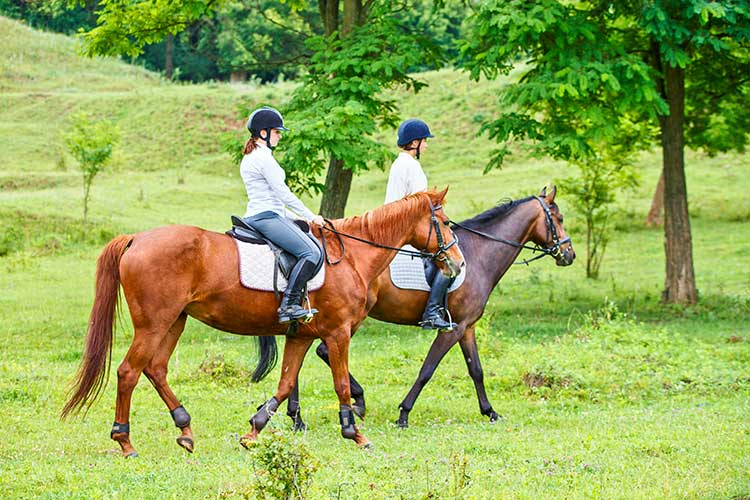Cross-Training Horses for Body and Mind
- Topics: Article, Sports Medicine

Can cross-training, popular with human athletes, have the same beneficial effects to our equine athletes?
“Whether it be a football player studying ballet or a dressage horse learning to work cows, cross-training is a central pillar to athletic success and longevity,” said Brianne Henderson, BVMS, MRCVS, of the Ferguson Equine Veterinary Services and Toronto Equine Hospital, both in Ontario, Canada.
As our expectations for our equine partners increase, so should our knowledge of injury prevention and our understanding of the psychology of the equine athlete. Equine sports medicine and training concepts found their beginnings in the pillars of human athlete science. Moving forward we now have the benefits of dedicated research laboratories and the experience of icons in the industry.
Injury Prevention
Cross-training allows us to spread the cumulative level of orthopedic stress over an increased number of muscles and joints. By “sharing the load” we are able to train longer at greater intensity without overloading vulnerable areas.
For example: A dressage horse (or a show jumper) requires a high level of hindquarter strength and endurance to maintain collection. An alternative to the typical “strength-training” exercises within the arena, the same horse would benefit from regular, controlled hill work to:
- Strengthen the muscles of the hindquarter without putting a focal stress on common areas of injuries (hock joints, suspensory ligaments, etc);
- Move the sacroiliac joint in a different pattern reducing the chance of repetitive strain associated with inflammation; and
- Give the rider and the horse a mental break from the intense training within the ring.
“It is critical for the mental and proper musculoskeletal development of the athlete to have for every three training days a day off or even better provide cross-training, like trail riding or swimming, on these days,” said Judith Koenig, DrMed Vet, DVSc, Dipl. ACVS, ECVS, of the University of Guelph’s Ontario Veterinary College.
Improved Fitness
One of the primary purposes of cross-training in human athletes is to build strength and aerobic fitness to a greater level. Do you find your jumper lacks the “umph” in the jump off round? Is your “schwung” a little lack luster after a multi-day dressage show? Aerobic fitness (or endurance) is a key element for any athlete being asked to perform over many hours or days.
Let’s look at a few examples:
- An endurance horse or hunter/jumper that is cross-trained with dressage could develop increased coordination and suppleness, and reduced injury risk as muscles tire during an event. Suddenly Mile 40 isn’t as much of a push and that tight turn off a jump off is more fluid!
- Conversely, a show horse which is hacked out or does the occasional 12- to 25-mile distance ride builds a greater aerobic capacity and endurance for long show weekends. In addition, in order to collect/shorten a muscle, we must first lengthen it and stretch it.
The combination of collected “heavy lifting” work alongside “long and low” hacking works the muscles in a different capacity, and reduces the risk of over loading on a specific structure (i.e. suspensory ligament).

The Science Behind the Art
As mentioned, cross-training can provide benefits, including:
- Increased cardiovascular fitness and musculoskeletal strength;
- Enhanced motivation by diminishing the potential for boredom; and
- A rejuvenated mind and body during breaks from formal training.
But why? Let’s look at the science behind these claims.
Bone is dynamic—its always changing and responding to stress. This bone remodeling is determined not only by growth, but also by mechanical loading on the bone.
Microdamage within the bone occurs as a consequence of repetitive strain. When this microdamage occurs, damaged cells send signals to remove the damaged bone and replace it with healthy bone.
Overtraining causes this “microdamage” to occur at a faster rate than the body can fix, so the repair is never as strong as the original bone. This creates a weak point in the bone and could set the horse up for future injury.
A similar microdamage-repair cycle occurs within the tendons and ligaments, however, they have a limited ability to self-repair quickly. Hilary Clayton, BVMS, PhD, Dipl. ACVSMR, MRCVS, of Sport Horse Science, highlighted an important difference between tendons and bone: Elastic tendons accumulate microscopic damage over the lifetime of the horse, which puts older horses at risk of exercise related damage.
The key to a strong musculoskeletal system is gradual and varied loading. Training at different gaits, on varied terrain, enables the bone and soft tissue to be stressed in different directions and reduces the effect of repetitive strain. This is as true for the dressage horse as it is for the racehorse.
Ring Sour Horses with Stereotypies
Some people recommend using hot walkers, treadmills, or underwater treadmills as alternatives for riding. From a purely physical perspective, all of these modalities provide excellent physical training, however, we must remember that in addition to the physical benefits of cross-training, we are also looking to keep our equine counterparts happy in their work. We should not gloss over the impact of the social relationship on the horses’ psyche.
Instead, we should make it an important part of the horses’ weekly schedule. Hacking or jump schooling in groups, cattle sorting, or beach riding are all options that can provide both physical and mental benefits when implemented correctly and safely. And, it can allows us, as riders, to spend an afternoon in the saddle without the stress of competition.
Written by:
Equine Guelph
Related Articles
Stay on top of the most recent Horse Health news with












